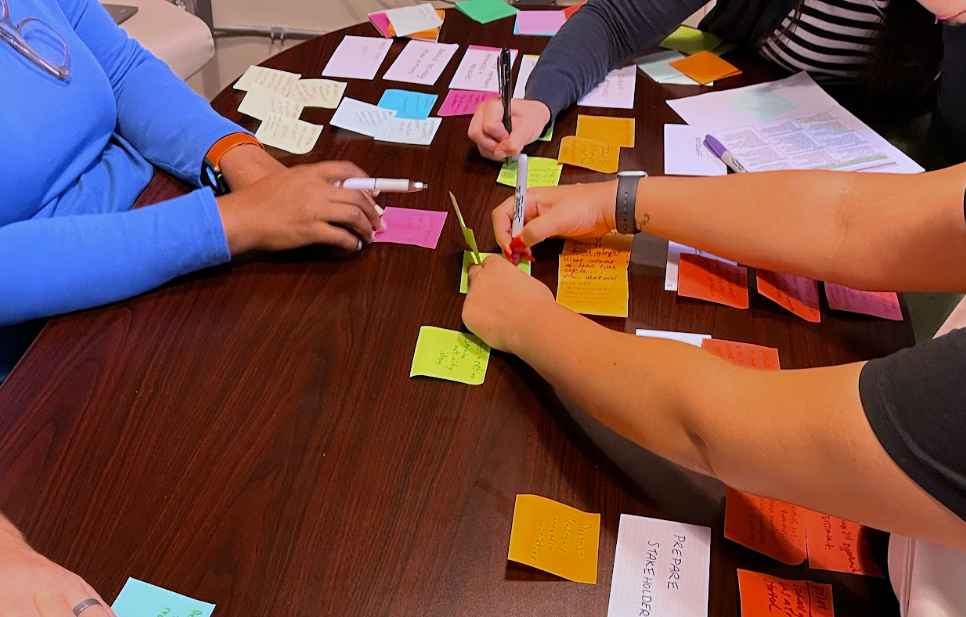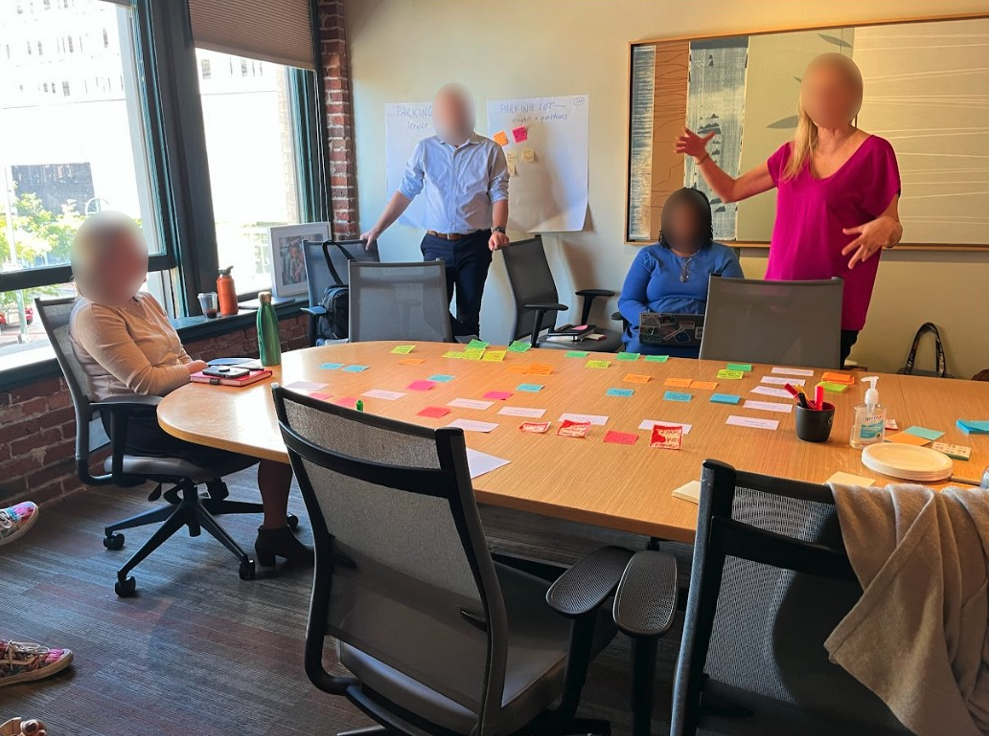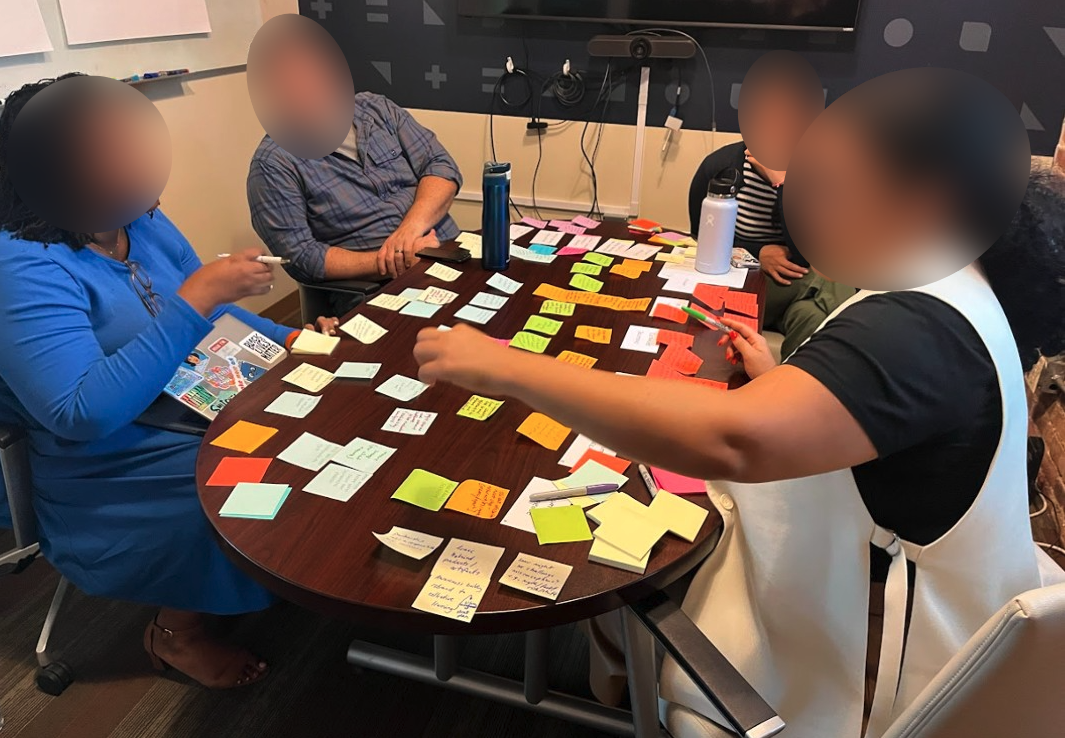Workshop Design & Facilitation: Collaborative Service Blueprinting
My approach to a service design workshop that prioritized inclusive participation and practical learning.

TNTP and America Succeeds forged a partnership to design services aimed at integrating durable skills into classrooms nationwide. After several months of exploration and dialogue, the team was set to transform their concepts into service models during an in-person workshop. This event also marked the first face-to-face meeting for team members who had previously worked remotely. This case study highlights the workshop's key outcomes and insights, showcasing its impact on participants and the trajectory of the organizations' partnership.
My Role
I was trusted to design and facilitate a half-day workshop that would (1) position all team members as valued contributors, regardless of design experience and (2) produce draft service blueprints for two distinct services.
- Workshop Design: Developed an inclusive workshop agenda that encouraged participation and idea-sharing from all team members, helping bridge gaps between experienced designers and novices.
- Facilitation: Used adaptive and relational facilitation techniques to maintain engagement and foster a collaborative atmosphere, ensuring that all voices were heard and creative solutions were explored collectively.
- Artifact Collection and Blueprint Development: Gathered and digitized workshop artifacts, transforming draft blueprints into polished, refined documents. Proposed actionable next steps for advancing the service design process, ensuring alignment with both organizations' strategic goals.
My Approach
I structured the workshop around three key objectives: facilitating learning, practicing essential service design techniques, and engaging participants in meaningful discussions.
We started by breaking down a simple definition of what a service is and aligning on the purpose, key stakeholders, and intended outcomes of the service models. I shared examples of service blueprints from previous projects and introduced a low-stakes scenario to foster camaraderie and encourage participants to collaborate actively.
"A service helps someone to do or achieve something while delivering an outcome for the organization providing that service." - Kate Tarling, The Service Organization
During the practice scenario, I observed variations in group dynamics; some participants were quick to engage, while others held back. I paused the activity to pose open-ended questions, prompting reflection on group dynamics and individual contributions. Participants were encouraged to crowdsource solutions, which I summarized before we began blueprinting the services.
I then divided the participants into two teams, each tasked with designing a service. Midway through, the teams shared their progress, and I facilitated a structured discussion with clarifying questions and suggestions, ensuring all voices were equally heard regardless of communication style.
At the day's end, we reflected on what worked well, factors that influenced participation, and our priorities as a design team moving forward. I documented and collected all design artifacts to support continued remote collaboration.


Workshop participants presenting and refining their service blueprints
Key Results
Facilitating workshops is one of my favorite parts of design because it allows me to engage with participants and explore creative ideas together. I was thrilled that this particular workshop went particularly well, as attendees actively participated and shared insightful feedback, making the entire experience rewarding and fulfilling. Participants shared the following feedback about the workshop:
- Educational Component: Participants were impressed with the unique structure that integrated learning, practice, and engagement. This holistic approach—uncommon in most partner meetings—proved highly effective in fostering a productive learning environment.
- Clarity and Scaffolding: The workshop's well-defined process and scaffolding allowed participants to engage fully, even those accustomed to different working styles. The clarity and guidance provided were appreciated, enabling participants to better understand service design approaches and apply them in action.
- Collaborative Environment: The workshop encouraged openness and collaboration, with participants appreciating the diverse perspectives present. This openness was further emphasized by removing hierarchical barriers and fostering a culture of inclusivity, where new ideas were welcomed.
Lessons Learned
If given the opportunity to lead a similar project again, I would prioritize:
- Collective Ownership: To enhance ownership and collaboration, a suggestion was made to swap participants between groups, reducing silos and fostering a sense of shared responsibility.
- Timing of Workshop: Conducting the workshop earlier in the partnership could have enriched remote meetings and enhanced overall collaboration.
- Design Context: Integrating fundraising and go-to-market strategies within the design context could provide a more holistic view of the service ecosystem.
Kind Words
"Your deep understanding and display of emotional intelligence throughout the session was remarkable. You demonstrated an acute self-awareness and modeled facilitation in a way that was inviting and clear. This created an inclusive and engaging atmosphere that encouraged participation at all levels.
I was particularly impressed by how you seamlessly integrated opportunities for learning and application in the design process, decision-making, and innovation discussions. This approach not only enriched the learning experience but also empowered me to think critically about service design in general.
Furthermore, your commitment to constant learning and willingness to share new resources has been so helpful. You consistently foster innovative thinking about our work, considering both the opportunities and inherent risks. Thank you for being an exemplary leader and partner in this work." -Project Team Member & Workshop Participant
